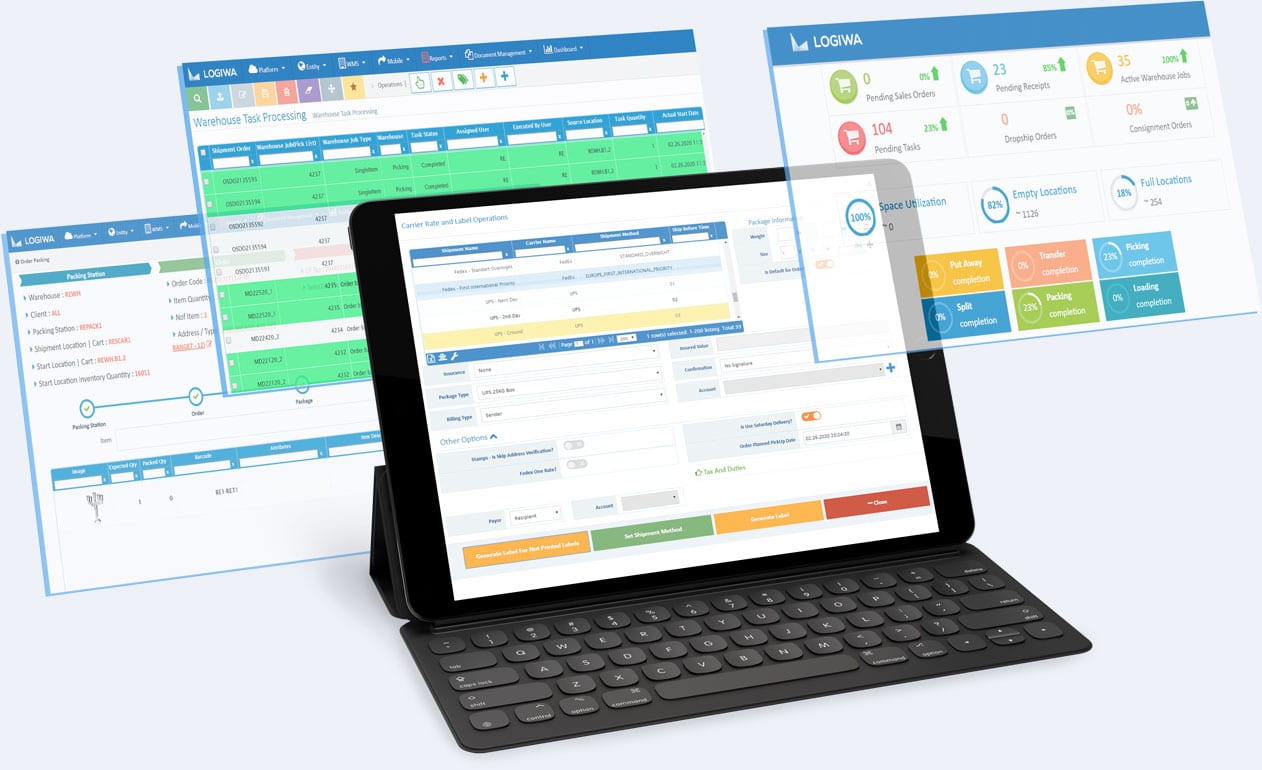8 Ways WMS Solutions Contribute to Supply Chain Visibility
Supply chain visibility is a crucial component to achieving high-volume DTC fulfillment success. Without it, brands, retailers, 3PLs and online sellers are unable to effectively meet consumer demand, manage complex logistics, or maintain the fulfillment standards required to grow in today’s competitive markets.
The good news is warehouse management systems (WMS) can provide businesses with the visibility they need to run high-efficiency fulfillment networks and supply chains. Modern solutions do more than just track inventory and warehouse operations; they allow operators to monitor supply lines, online orders, the status of shipments, and so much more.
In this blog, we’ll discuss the impact supply chain visibility has on fulfillment logistics, how leading WMS solutions can ensure optimal insight and control, and the profound effects visible supply chain-fulfillment can have on DTC growth.
Key Takeaways
- Supply chain visibility means having dependable insight into suppliers, vendors, and distributors, as well as the activity taking place across ecommerce channels, warehousing operations, and shipping resources.
- When supply chain visibility is in place, you are able to optimize the processes that make up your fulfillment operations and change the ones that are inhibiting success.
- A top-notch WMS ensures supply chain visibility in order to streamline logistics and create high-efficiency fulfillment networks.
- A WMS provides supply chain visibility through real-time data integration, inventory tracking, live order management, ongoing resource optimization, demand forecasting, partner collaboration, rapid issue resolution, and compliance assistance.
- As ecommerce continues to evolve, advanced WMS solutions like Logiwa WMS play a pivotal role in helping DTC fulfillment operations achieve real-time visibility.
Contents
The Importance of Supply Chain Visibility for Fulfillment Logistics
Supply chain visibility means having dependable insight into suppliers, vendors, and distributors, as well as the activity taking place across ecommerce channels, warehousing operations, and shipping resources. From tracking the movement of products, orders, and financial transactions to ensuring final shipments are delivered – you must be able to track the various components of your business as they progress through each stage of your supply chain.
When supply chain visibility is in place, you are able to optimize the processes that make up your fulfillment operations and change the ones that are inhibiting success. Moreover, supply chain visibility helps with anticipating logistics problems and reacting proactively to avoid costly inventory problems, prevent fulfillment delays, and circumnavigate disruptions that may be stemming from specific partnerships (i.g. vendors, shippers, distributors, etc.).
Without being able to see the complete picture of supply chain operations, it becomes much harder to streamline fulfillment logistics, respond efficiently to change, and scale competitively. For insights into improving logistics through enhanced supply chain management, check out Logiwa’s blog, “Optimize Your Supply Chain Management.”

Transform your warehouse to a DTC fulfillment center
8 Ways a WMS Helps Improve Supply Chain Visibility
Warehouse management technology has become a critical component for managing DTC supply chains and fulfillment logistics. A top-notch WMS ensures supply chain visibility in order to streamline logistics and create high-efficiency fulfillment networks.
Historically, warehouse management systems focused solely on warehouse operations: inbound processes like receiving and putaway, inventory management, and picking, packing and shipping tasks. Now, they can do a lot more.
1. Real-time Data Integration:
WMS solutions act as a central hub for your supply chain data, seamlessly integrating information from various sources throughout your fulfillment network. This often includes information on your suppliers, distributors, warehouses, ecommerce channels, and shippers. By aggregating inventory, order, and workflow data in real-time, you are able to maintain a holistic view of supply chain operations. This transparency empowers you with accurate and up-to-date information to identify bottlenecks, forecast demand, and adjust strategies as needed.
2. Accurate Inventory Tracking:
Inventory management lies at the heart of supply chain visibility. A robust WMS enables accurate and real-time tracking of inventory levels, locations, and movements within the warehouse. This data not only helps you prevent stockouts or overstock situations but also assists in optimizing inventory levels, reducing carrying costs, and improving order fulfillment accuracy. Plus, with cloud-based solutions, you can easily add in new lines of inventory at locations experiencing high levels of traffic to ensure all fulfillment needs are consistently met.
3. Streamlined Order Fulfillment:
A WMS enhances order fulfillment processes by automating tasks such as order picking, packing, and shipping. With the ability to track and manage the live orders coming in through ecommerce channels, you can expedite workflows, provide accurate delivery estimates to customers, manage last-minute changes, and complete on-time deliveries. This level of precision enhances customer satisfaction and strengthens brand loyalty, and it all stems from high levels of visibility.
4. Efficient Resource Utilization:
The supply chain visibility provided by a WMS enables the optimization of resource allocation for multi-warehouse operations. By analyzing historical data and real-time trends, the BI tools embedded within a WMS can help allocate labor, equipment, and storage space more efficiently, as well as route orders to the best locations based on inventory levels and fulfillment goals. This results in reduced operational costs, improved labor productivity, and overall better resource management.
5. Demand Forecasting and Planning:
A significant challenge in supply chain management is forecasting consumer demand and inventory needs accurately. WMS solutions leverage historical data and predictive analytics to provide insights into demand patterns, enabling businesses to coordinate procurement, plan distribution, and designate stocking levels accordingly. This proactive approach minimizes the risk of stockouts and excess inventory, which help your operation grow long-term.
6. Enhanced Collaboration:
Collaboration among supply chain partners is essential for seamless operations, especially when it comes to ecommerce providers and shipping carriers. Well-integrated WMS solutions facilitate communication and coordination by providing real-time visibility into your inventory levels, order statuses, shipment tracking, and more. This level of seamless data exchange and transparency fosters better communication, more successful relationships, and quicker issue resolution for you and your stakeholders.
7. Rapid Issue Identification and Resolution:
Supply chain disruptions can arise from a variety of sources such as transportation delays, quality issues with a supplier, or sudden changes in demand. A modern WMS aids in rapid issue identification by monitoring the flow of goods through workflows, inventory levels, changes in orders, and other discrepancies within its system. When anomalies occur, such as shortages, spikes in returns, or item expirations, a WMS can send out an alert, so you can take immediate action. This is especially prevalent in WMS solutions paired with scanning, sensors, or RFID technology, which help ensure accurate digitized networks, and streamline supply chain processes from start-to-finish.
8. Compliance and Traceability:
Regulatory compliance and traceability have become critical aspects of modern supply chains, and fulfillment operations are no exception. A WMS helps maintain compliance by accurately tracking critical product information related to its origins, lot batch numbers or expiration dates (if applicable), and stock movement. In the event of a recall or audit, your team can quickly retrieve detailed information about the affected products, ensuring consumer safety and regulatory adherence.
The Results of Visible Supply Chain-Fulfillment
Using a WMS to aid supply chain visibility is a strategic move that can significantly improve the overall performance of DTC fulfillment operations. By centralizing data, automating supply chain processes, and leveraging real-time insights, you help to ensure:
- Stable, flexible fulfillment operations;
- Cost-effective inventory control (maintaining the correct levels);
- Optimized order management and fulfillment processes;
- Improved customer satisfaction and higher customer retention; and
- Business and fulfillment network growth.
For more insights into order management and routing, inventory control, and optimized shipping using supply chain visibility software, check out our QuickTake webinar “Gaining Visibility & Control Over High-Volume DTC Fulfillment.”
Logiwa WMS Ensures Real-Time Visibility for High-Volume DTC Fulfillment
As ecommerce continues to evolve, advanced WMS solutions have become essential for businesses seeking to thrive in today’s dynamic supply chain environment. In this fast-paced, interconnected landscape, WMS providers like Logiwa play a pivotal role in helping DTC fulfillment operations achieve real-time visibility.
Logiwa is more than a WMS, it’s a complete fulfillment solution with seamless integrations to ecommerce platforms, shipping carriers, ERPs and accounting solutions. Our cloud infrastructure is designed to support modern fulfillment networks with powerful shipping and analytics features – Logiwa WMS ensures competitive visibility that takes digital warehousing to the next level.
To learn more, request a free consultation and demo of our solution today.
FAQs about Supply Chain Visibility
What is supply chain visibility?
Supply chain visibility is having dependable insight into operational suppliers, vendors, and distributors, as well as the activity taking place across ecommerce channels, warehousing operations, and shipping resources. It includes being able to track products, orders, financial transactions, inventory levels, processing status, and shipments as processes are carried out through each stage of a supply chain.
Why is supply chain visibility important in fulfillment logistics?
Supply chain visibility is important to fulfillment operations because it allows businesses to optimize the operational processes and strengthen ones that are inhibiting success. Moreover, supply chain visibility helps with anticipating logistics problems and reacting proactively to avoid costly inventory problems, prevent fulfillment delays, and circumnavigate disruptions that may be stemming from specific partnerships.
Do WMS solutions aid supply chain visibility?
Yes, WMS solutions help warehouse operators monitor supply lines, online orders, inventory levels, the status of shipments, and all the processes related to fulfillment.
How do WMS solutions provide supply chain visibility?
A WMS provides supply chain visibility through real-time data integration, inventory tracking, live order management, ongoing resource optimization, demand forecasting, partner collaboration, rapid issue resolution, compliance assistance, and more.
Make high-volume order fulfillment your competitive advantage
Warehouse Management
Modern digital WMS powers a modern fulfillment experience





